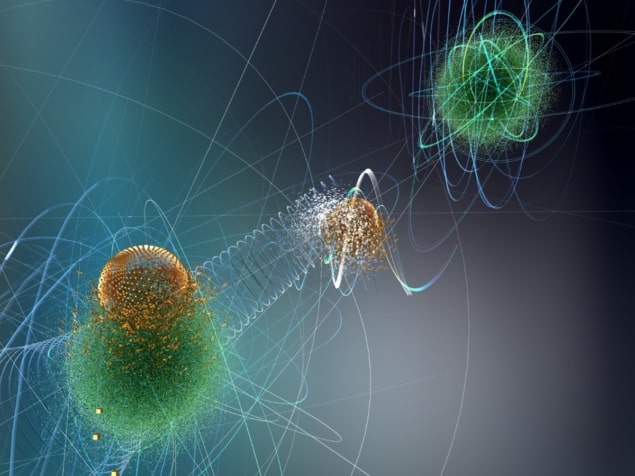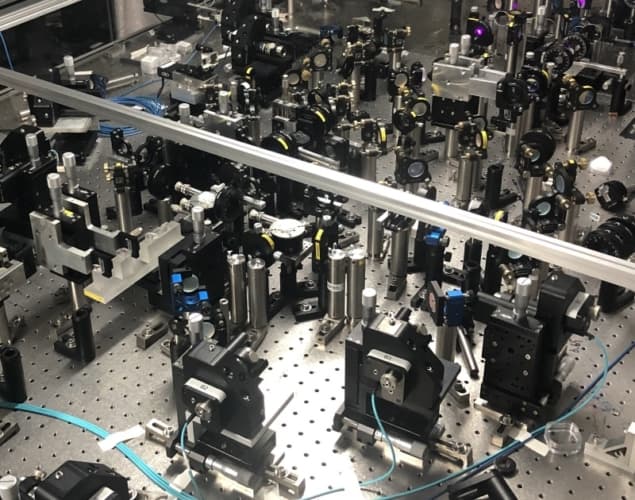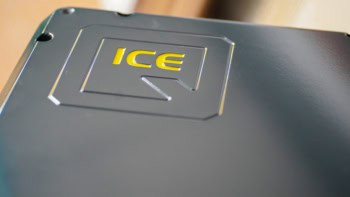
Physicists in China and Austria have shown for the first time they can teleport multi-dimensional states of photons. Carrying out experiments using photons encoded via three spatial states, they say their scheme can be extended to arbitrarily high numbers of dimensions and is a vital step in teleporting the entire quantum state of a particle. The work could also improve technology used in quantum communications and quantum computing.
Quantum mechanics forbids the quantum state of one particle from being copied precisely to another particle. But teleportation – the instantaneous transfer of a state between particles separated by a long distance – offers an alternative. The process involves no physical transfer of matter and erases the state of the particle to be copied.
The basic idea is that Alice and Bob share a pair of entangled particles (in the terminology of quantum cryptography, Alice being the sender of a message and Bob the receiver). Then Alice interacts a third particle – in an unknown state – with her half of the entangled pair, measures the outcome of the interaction, and then tells Bob the result via a classical channel. Given that information and a measurement on his half of the entangled pair, Bob is able to work out the original unknown state – which is what has been teleported.
First proposed theoretically in 1993, quantum teleportation has since been demonstrated in many different guises. It has been carried out using two-level states of a single photon, a single atom and a trapped ion – among other quantum objects – and also using two photons. Then in 2015 Chaoyang Lu, Jian-Wei Pan and colleagues at the University of Science and Technology of China in Hefei demonstrated teleportation of two degrees of freedom – spin and orbital angular momentum – between single photons.
In the latest work, the same group, working with Anton Zeilinger and colleagues at the University of Vienna in Austria, has demonstrated teleportation of higher-dimensional states. As Lu explains, being able to transfer multiple degrees of freedom is only part of the challenge. That’s because particles in nature have properties that can take on many possible values, rather than the simple binary states (qubits) used in experiments to date. He says that even the simplest atom – hydrogen – can potentially exist in four different ground states and many excited states.
Measuring the Bell state
The chief difficulty in doing this, says Lu, is Alice’s initial measurement of the “Bell state” between the photon to be teleported and her half of the entangled pair. That measurement requires that the two photons interact with one another, but that interaction is extremely weak. There is a straightforward way around this problem when dealing with two dimensions, he says, but not for any higher number.
In two dimensions there are four possible Bell states, given that each photon can exist as a 1 or a 0: 00+11, 00-11, 01+10 and 01-10. Because three out of these four states are “symmetric” – meaning that switching the two particles leaves the combined wavefunction unchanged – the fourth “asymmetric” state can be unambiguously identified, allowing the state to be teleported successfully. However, in three dimensions there are nine possible states, three of which are antisymmetric, while the remaining six are neither symmetric nor antisymmetric.

To overcome this problem, the researchers built a complex network of linear optical components linking multiple inputs with multiple outputs. The trick was to tap four different photons – the one to be teleported, the two being entangled and an extra one to enable successful Bell-state measurements. The photons were generated by a pulsed ultraviolet laser and then split along three different paths – to represent the three dimensions – with the three photons at Alice’s end then interfering with one another. The patterns of clicks from detectors recording the interferometers’ output revealed whether the three photons had been projected into a specific Bell state and could therefore be used for teleportation.
In a paper posted on arXiv, and accepted for publication in Physical Review Letters, Lu and colleagues report having successfully teleported photons 75% of the time – by preparing the input photons in a known, specific state and comparing them with the teleported photons (a standard procedure in teleportation experiments). This fidelity of 0.75, they point out, is well above the upper limit of 0.5 possible without entanglement, as well as the 0.66 that could conceivably be achieved with qubits only.
Towards higher dimensions
Lu says that the scheme could be scaled up quite easily to four, five or more dimensions mainly by adding a few more beam splitters, although he reckons that integrating the components on a photonic chip might be more practical for very large numbers of dimensions. More generally, his group is now looking to combine these higher dimensions with multiple degrees of freedom to try to teleport complete particles. “That is a necessary step if we ever want to teleport complex systems,” he says.
Technologically, Lu says that high-dimensional teleportation could be used to extend quantum communication networks – potentially providing higher bandwidth, more secure repeaters than could be achieved using qubits. It might also speed up logic operations inside quantum computers, he reckons. What’s more, he says, higher-dimensional Bell tests could provide greater scrunity of Einstein’s idea of local realism, since they would yield an even more extreme difference between classical and quantum measurements.
Lu and colleagues are not the only researchers to have demonstrated higher-dimensional teleportation. Guang-Can Guo and co-workers, also based at the University of Science and Technology of China in Hefei, have likewise reported teleporting photons in three-dimensions. Their scheme was quite similar to Lu’s but relied on two extra photons to carry out the Bell state measurement, rather than one. They also appear to have achieved a slightly lower fidelity – reporting a figure of “above 0.63”.


